My friend tells me that I can get a good dry suit for swimming in ice filled lakes for around 500 to 600 dollars plus a dry hood, gloves and fins which would likely be extra beyond that. So, I'm thinking that for around 800 to 1000 dollars one could buy everything they need for warmth while ice diving in rivers and lakes with ice in them. But, one needs to be very careful with all of the variables while doing this and if one wants to stay alive this isn't something you do alone.
Within the last 3 years or so two of my friends and I were skiing across Castle lake and the temperature was about 20 degrees Fahrenheit and cloudy with a 20 mph wind. But still, the ice on the lake wasn't very thick so I made it a point not to ski where I might fall through because I'm 6 foot 5 inches tall, big boned and not a light weight. So, if I fall through the ice I only want to go up to my waist and that's all. I was fine until I skied from the shore down a hill onto the ice but when I shifted from one type of snow to ice I didn't compensate right because I was trying not to be knocked down by a snow covered tree branch. This didn't work and I wound up going back on my skis and my rear end broke through the ice. So now, I'm rear end broken through the ice and still attached to my skis and poles. So, I called to my friend and it took one friend about 3 or 4 minutes to get to me to help me get off my skis before I went deeper into the lake and drowned there. Then I had to stand up in 3 feet of water and walk out of the lake all at about 20 degrees with about 20 mph of wind going by too. Luckily, I was only about a block or two from my 4 wheel drive truck. Since I was starting to go into hypothermia from heat loss I let someone else drive because you start to shake and if you aren't careful also start to hallucinate from hypothermia (extreme heat loss). I didn't have other pants to change into so I left the ones I had on for 1/2 hour back into town to my hotel room where I got into super hot bath tub water to thaw out for several hours. By the next day I was okay with no frostbite so I was very lucky.
Begin quote from:
dry suit
Dry suit
U.S. Navy divers in dry suits prepare to dive
The main difference between dry suits and wetsuits is that dry suits are designed to prevent water entering. This generally allows better insulation making them more suitable for use in cold water. Dry suits can be uncomfortably hot in warm or hot air, and are typically more expensive and more complex to don. For divers, they add some degree of operational complexity as the suit must be inflated and deflated with changes in depth in order to minimize "squeeze" on descent or uncontrolled rapid ascent due to excessive buoyancy.[6]
Dry suits provide passive thermal protection: They insulate against heat transfer to the environment.[6] When this is insufficient, active warming or cooling may be provided, usually by a hot-water suit, which is a wetsuit with a supply of heated or chilled water from the surface, but it is also possible to provide chemical or electrically powered heating accessories to dry suits.
Contents
- 1 Components
- 1.1 Essential components
- 1.2 Accessories
- 1.2.1 Thermal undersuits
- 1.2.2 Suspenders
- 1.2.3 Gloves, mitts, and three-finger mitts
- 1.2.4 Hoods
- 1.2.5 Helmets
- 1.2.6 Boots
- 1.2.7 Attachment rings
- 1.2.8 Valves
- 1.2.9 Suit inflation gas supply
- 1.2.10 Inflation hose
- 1.2.11 Zipper protection flaps
- 1.2.12 The P-valve
- 1.2.13 Gaiters, ankle straps and ankle weights
- 1.2.14 "Bio-seals"
- 1.2.15 Active heating
- 2 Applications
- 3 Manufacture
- 4 Care of suit
- 5 Hazards of use
- 6 History
- 7 See also
- 8 References
Components
Essential components
The essential components include a shell of watertight material, sufficiently flexible to allow the wearer to function adequately, seals where parts of the body pass through the suit while in use, and a method of sealing the access opening while the suit is worn. Insulation may be provided in part by the suit shell, but is usually largely provided by thermal insulation clothing worn under the suit, which relies to a large extent on trapped air for its insulating properties. An inflation valve with gas supply and dump valve are generally provided, but were not standard on early models.[7]Shell
The main part of the dry suit is a waterproof shell made from a membrane type material, foamed neoprene or a hybrid of both.[6]Membrane
Rubber on two way stretch knit fabric has an external surface that is relatively easy to decontaminate[8]
Membrane drysuit in icy water
To stay warm in a membrane suit, the wearer must wear an insulating undersuit, today typically made with polyester or other synthetic fiber batting. Polyester and other synthetics are preferred over natural materials, since synthetic materials have better insulating properties when damp or wet from sweat, seepage, or a leak.[6]:73
Reasonable care must be taken not to puncture or tear membrane dry suits, because buoyancy and insulation depend entirely on the air space in the undersuit, (whereas a wetsuit normally allows water to enter, and retains its insulation despite it). The dry suit material offers essentially no buoyancy or insulation itself, so if the dry suit leaks or is torn, water can soak the undersuit, with a corresponding loss of buoyancy and insulation.[6]:73
Membrane dry suits may also be made of a waterproof but breathable material like Gore-Tex to enable comfortable wear without excessive humidity and buildup of condensation. This function does not work underwater. Sailors and boaters who intend to stay out of the water may prefer this type of suit.[9]
Neoprene
The neck seal, the zip, the inflator, a wrist seal, and the manual cuff vent of a neoprene dry suit
Neoprene dry suits are generally not as easy to put on and remove as are membrane dry suits, largely due to a closer fit which is possible due to the inherent elasticity of the material, and partly due to greater weight. As with wet suits, their buoyancy and thermal protection decreases with depth as the air bubbles in the neoprene are compressed. The air or other gas in the dry fabric undergarments providing insulation under a dry suit is also compressed, but can be restored to an effective volume by inflating the drysuit at depth through an inflator valve, thus preventing "suit squeeze" and compacting of the air-filled undersuit. Foam-neoprene tends to shrink over the years as it loses gas from the foam and slowly becomes less flexible as it ages.[7]:56 An alternative is crushed or compressed foam neoprene, which is less susceptible to volume changes when under pressure. Crushed neoprene is foam neoprene which has been hydrostatically compressed so much that the gas bubbles have been mostly eliminated, this retains the elasticity of foamed neoprene which allows freedom of movement, but does not provide much insulation, and is functionally more like a membrane suit.[7]:57
Hybrid
Some suits marketed as hybrid suits combine the features of both types, with a membrane top attached to a neoprene bottom near the waist.[10][7]:33 The neoprene part is usually configured as a sleeveless "farmer-john" that covers the torso as well. This style is often used for surface water sports, especially in very cold water. The tight fitting lower part lets the wearer kick while swimming, and the loose fitting top allows easy arm movement. The torso covering also provides additional self-rescue or survival time if the suit leaks.[citation needed] Other manufacturers such as "Waterproof", use the term to refer to a membrane suit with integral liner of a relatively compression resistant porous 3-dimensional mesh, which creates a thin but resilient air space between the suit shell and the diver.[11][12]Seals
Silicone neck seal attached with clamping ring - view inside the suit
Silicone dry suit cuff seals with clip-on clamping rings: above - assembled, below - components
A recent innovation is the silicone seal, which is claimed to be as supple as latex, more flexible, yet far more durable. These are now available as original equipment on some makes of dry suit. Silicone seals are hypoallergenic, but can not be glued to the suit, and must be attached using clip-on rings. The silicone seals are similar in mechanical strength to latex seals but do not deteriorate as rapidly from oxidation and chemical attack. They are initially relatively expensive, but can be replaced without tools by the user which reduces cost of replacement.[13][14]
Waterproof entry
Shoulder (rear entry) zipper
Plastic watertight dry suit zipper: tooth and seal edge detail - the
watertight seal is made by pressing together the continuous ridge along
the middle of the teeth when the zipper is closed.
Front entry zipper
Plastic watertight dry suit zipper: detail of closed teeth showing interlock above and (not visible) below the seal edge.
Before truly watertight zippers were invented, other methods of keeping the suit waterproof at the entry point were used, with the most common being a long rubber entry tunnel which would be folded shut, then rolled together from the sides and finally folded and clamped with a metal clip.[7]:14 An early example was the Sladen suit, where the entry tunnel was at the front of the torso. The Louisiana-based dry suit company Aquala makes a "historical" diving suit of that kind.[15] Another type of entry featured a rubber tunnel that protruded through a non-watertight zipper. The tunnel would be rolled shut and the zipper closed to hold the roll in place.[citation needed]
Accessories
Thermal undersuits
Most drysuits do not provide sufficient insulation without suitable undergarments. The type of undergarment selected will depend on the water temperature, type of suit and dive plan. The purpose of the undergarment is to maintain the diver in comfortable thermal balance, where the heat lost is balanced by the heat generated by the diver. More insulation is needed for colder conditions and for less energetic diving activity.[7]The principle of layering can be used to provide a wider range of insulation possibilities from a relatively small range of underwear items, however this can only be done before entering the water. Most dry suit underwear insulates by a trapped layer of air in the garment, and this is largely lost if the air is replaced by water in a flooded suit, so as a general rule, insulation is proportional to the combined thickness of the undergarments. The layering principle shows that the option of two layers of undergarment in two thicknesses allows three levels of insulation to be selected. Thin only, thick only, and both layers.[7]
Some materials have better insulating properties than other when wet, and will keep the diver warmer if the suit leaks or floods. The best dry suit undergarment is the thinnest material that will provide the required insulation, by trapping air in the smallest spaces. These will require less air in the suit and thus less excess buoyancy for which weighting will be required.[7]
The moisture given off by the human body, even when not exercising and sweating, will condense against the inside of the dry duit, and the way this condensate is handled by the underwear material will influence the comfort of the diver. If the underwear soaks up this moisture it will feel cold and clammy, particularly if this layer is against the skin. Materials which wick the moisture away from the skin and do not soak up the condensate will be more comfortable.[7] Early thermal undersuits for drysuits were commonly made from wool, as it retains its insulating properties better when wet than most other natural fibres.[16]
The fit of the underwear should allow the same range of movement as the suit itself, and together should allow the diver to bend, squat, kneel, climb a ladder, fin and reach all critical parts of the diving equipment. Underwear which is flexible and stretches, particularly at the joints, will allow the diver more freedom of movement, and is less likely to chafe, and materials which resist compaction under light pressure will maintain a more even thickness in use, which will provide better insulation for the same overall volume.[6]:76
For cold-water use, especially diving under ice, the user will usually wear a thick undersuit in a membrane dry suit. The thickness of undersuits varies and can be chosen by the wearer according to the water temperature. Thinsulate is one of the preferred fabrics for undersuits.[17][18]
The hydrophobic qualities of Thinsulate help prevent water absorption which helps to maintain the insulating airspace even in the presence of free water.[7] More recently, aerogel material is being added to conventional undergarments to increase the insulating properties of those garments.[19] Polar fleece is a good insulator with good stretch, is lightweight, and dries quickly if it gets wet. It is also hypoallergenic and comfortable against the skin. Polyester liners can add to the insulation and will wick perspiration away from the skin. Cotton is not recommended as it absorbs moisture and saturates easily, and will then rapidly conduct heat away from the body. Most dry-suit underwear is full length, either as a one piece or jacket and trousers, but a vest may be added for extra insulation on the torso, and a "Farmer John" style trousers with jacket is flexible and puts extra insulation where it is most useful.[7]
Neoprene dry suits are made from a foam-rubber sheet containing tiny air bubbles, which provide insulation by themselves, and can eliminate the need for an under-suit, or greatly reduce the thickness needed for the under-fabric, but the bubbles in the neoprene are compressed and the insulation of the suit decreases with depth in the same way as for a wetsuit.[6]:55 Crushed neoprene provides the flexibility of neoprene with the consistent buoyancy and insulation of membrane suits.[6]:57 A neoprene wet suit can also be worn under a membrane dry suit for extra protection against condensation and leaks, but it will compress with depth as will any closed cell suit.
Undersuits used for surface watersports are generally thinner than those used for diving, and are commonly made from fleece material.[citation needed]
Suspenders
Some dry suits are provided with internally attached suspenders which when hooked over the shoulders, will hold the trouser section up when the top part of the suit has not yet been fully dressed into by the diver, this is also convenient if the suit is partly removed between dives for comfort. The suspenders also help to keep the trousers fully lifted if the torso of a membrane suit is a little long to provide enough space for the diver to bend the torso comfortably when in use. If the crotch hangs too low it encumbers the legs when finning, and increases the risk of the feet pulling out of the boots in an inversion.[7]Gloves, mitts, and three-finger mitts
Dry suits may have wrist seals, permanently attached gloves or mitts, or removable dry gloves connected by attachment rings.[7]:84Permanently attached gloves or mitts are unusual, It is more common for them to be connected by attachment rings. Either way, the absence of a wrist seal makes getting in and out of the suit much easier since there is no need for the suit to tightly seal around the wrists. It may be necessary to use a wrist strap to prevent loose gloves pulling off the hands when filled with air. Dry gloves can also be fitted over a wrist seal, which prevents leakage into the sleeves if the gloves are penetrated.[5]:81
Full-hand diving mitts can be sometimes useful in extreme environments such as ice diving, but significantly reduce dexterity and grip.[7]:84 Dry gloves and mitts usually allow a dry insulating glove to be worn underneath.[5]:82
Three-finger mitts are a compromise between gloves and mittens. In the three-finger mitts, the fingers are arranged with the index finger in a separate pocket to the other three fingers. This provides slightly better hand-grasping dexterity while still permitting heavy insulation around the hands.[7]:84
Hoods
The dry suit may also have an integrated hood, which seals water out around the wearer's face, and helps keep the wearer's head warm. The integrated hood is often latex rubber that fits tightly around the head, but can also be made from neoprene or membrane to allow an insulating cap to be worn under the hood. Care must be taken to avoid the hood making a waterproof seal around either of the ears, as this could cause an eardrum bursting outwards at depth.[citation needed]Separate (non integral) hoods are of two types: one which extends only to the base of the neck, and the other a standard wetsuit hood with a large flange. Hoods are never tucked into the neck seal as they would be tucked into a wetsuit, as this would compromise the watertight integrity of the seal. Some suits are designed with a second (non-watertight) "warm neck collar" around the neck seal, which allows the flange of a standard wetsuit hood to tuck in around the outside of the seal. This can keep the neck significantly warmer, since the seal itself provides little insulation.[7]
Helmets
To provide more protection to the head against impact, to secure the airway, and to permit easy communication with the surface and between divers, a rigid metal or fibre-reinforced plastic diving helmet may be worn with the dry suit. This can be separate from the dry suit with its own watertight neck seal, or it can be clamped onto a neck ring attached to the suit, so that air can flow between the helmet and the suit.[5]Boots
Most commercial diving dry suits have heavy duty integral boots. Sport diving suits may have lightweight integral boots or soft neoprene booties. Rock boots or heavy working boots may also be worn over integral neoprene or latex socks. Boots which are stiff at the ankle make finning inefficient and are unsuitable for many diving applications where mobility is important. If the suit will be used by a diver who needs to fin efficiently on some dives and to walk on sharp surfaces on other dives, it is more effective to wear boots suited to the dive over a dry suit with integral socks.[6]:49[7]:44Surface dry suits may have socks or ankle seals fitted. Socks are normally made from latex rubber or from a breathable material similar to the rest of the suit. An outer boot or shoe would normally be worn over these socks to protect them from wear and the risk of puncture. The outer boot also provides more warmth than the thin layer of latex. A regular sock (e.g. a woollen sock) would normally be worn inside the drysuit sock for comfort.[20] Latex rubber ankle seals are sometimes fitted in place of socks and can allow better foot control of water skis and surfboards. Survival suits may have neoprene socks of the same material as the suit, with tougher soles and ankle ties to keep them on the feet, as the "one-size fits all" socks must be too big for most users.[21][22]
Attachment rings
Dry suits with latex seals; Top: quick-change seal (Viking ring); Bottom: glued seal.
More recently, on both commercial and recreational suits, "quick-change" rings have become increasingly common. These are permanently glued to the suit and accessories, either during manufacture or as a retrofit. These systems form a watertight seal between the suit and components using soft rings on both pieces that comprise a series of interlocking channels, similar in principle to a common food storage bag. Quick-change rings allow a diver to easily replace a damaged seal on the surface with no tools or adhesives, or to change attachments depending on conditions–for example, choosing between dry gloves and standard wrist seals. Different manufacturers' ring systems are generally incompatible, so the diver must choose accessories that are designed for the ring system on his or her suit.[7]:41
Valves
Inflation valve on neoprene suit
Auto dump valve on neoprene suit
The inflation valve is to compensate for air compression on descent. The air inside the suit is compressed on descent squeezing the suit tightly and painfully onto the diver's body, especially where the suit folds. Suit squeeze also compresses insulating garments, reducing thermal protection, hinders the diver's freedom of movement and interferes with buoyancy control. This is avoided by injecting compensating gas from the breathing gas cylinder, a small, dedicated inflation cylinder or the umbilical, via the inflation valve controlled by the diver. Environmentally sealed suits which are sealed to the helmet automatically equalise from the breathing gas.
The exhaust valve lets the diver vent expanding gas from the suit during the ascent. On ascent the air in the suit expands making buoyancy control difficult or impossible. This may cause an uncontrolled ascent resulting in missed decompression stops, decompression sickness, arterial gas embolism or pulmonary barotrauma. The manual exhaust allows the diver to control the suit volume; this may incorporate an automatic, adjustable exhaust or there may be a separate automatic, auto dump, valve on the shoulder. Automatic valves can be set to release at a pre-set pressure and in most situations, the diver can leave the automatic valve at a constant setting throughout the dive so that it releases with a small amount of over-pressure venting as needed automatically as the diver ascends.[23] There are many different configurations but automatic vents are generally at the left shoulder, and manual vents are at the wrist. Environmentally sealed suits used for diving in contaminated water have no dump valve, but are clamped to the helmet with a watertight seal, so the exhaust valve of the helmet functions as a dump valve. Some, now rare, older dry suits may have no vents, requiring the diver to lift one of the wrist seals or the neck seal open to vent the suit. Surface dry suits do not normally have exhaust valves, but the wearer may vent excess air by crouching down and hugging the legs while slipping a finger under the neck seal.
Suit inflation gas supply
Aluminium cylinder and valve intended for argon at a maximum pressure of
139 bar to be used for the inflation of a dry suit while scuba diving
Dry suit inflation only applies to diving. Survival suits and other dry suits designed for wear on the surface have no inflation or dump valves as suit squeeze and achieving neutral buoyancy are not issues.
Inflation hose
Seatec quick disconnect end fitting commonly used for dry-suit and buoyancy compensator inflation
Low pressure inflation hose with CEJN connector (right) used for some dry suits
Zipper protection flaps
Some suits are provided with a flap which can be closed over the outside of the zipper to protect it from being damaged by contact with the diver's equipment or the environment. these flaps may be held in place by velcro or a non-watertight outer zipper.[7]:105The P-valve
For commercial divers or technical divers who may spend many hours in a dry suit underwater, it is not practical to have to climb back on board the ship in order to open a waterproof relief zipper and urinate. The P-valve is a urinal built into the suit, which enables a diver to urinate at any time without having to get out of the water, while keeping him or her dry and clean inside the suit.[27]Before putting on the dry suit, the male diver puts on a condom catheter, which is similar to a condom except that it is made of thicker material with a cuff or adhesive ring to prevent it from slipping off, and its end connects to a built-on drain tube. After putting it on, he attaches the end of the tube to a drain hose in the crotch of the suit. This hose leads to a fitting through the front of one thigh of the suit, either with a screw-down outlet valve (P-valve), opened for use, or a non-return valve to prevent water from flowing back in if the hose gets disconnected. There may also be a non-return equalisation valve allowing gas from inside the suit to flow into the hose to avoid squeeze during descent The female diver puts on an external catching device in the form of a wide-rimmed, low-profile, elongated cup. The rim is affixed onto the skin surrounding the labia with medical grade glue. The cup's outlet connects to the drain hose with similar fitting on the suit.[27][28]
Risks involved with the use of the P-valve can include urinary tract infection, pneumaturia and genital squeeze.[27]
Divers expecting the need to urinate in dry suits can also use an adult diaper / nappy, which soaks up and retains the urine.[6][27]
Gaiters, ankle straps and ankle weights
Most suits have relatively baggy trouser legs to allow passage of the feet to the boots. This can hold a large volume of air when inverted, which may pull the boots off the feet.[7]:121 Elastic or tailored "gaiters" can be pulled snug around the lower legs to reduce the potential airspace to help prevent an inversion event and help maintain horizontal trim. Gaiters may also reduce hydrodynamic drag when finning, reduce the risk of the feet pulling out of the boots when inverted, and can be used effectively on membrane and neoprene suits. Ankle straps perform a similar function.[7]:45 Small ankle-weights (typically one or two pounds) can also be used with any dry suit, both to provide trim weight at the bottom of the suit, and function as short gaiters to constrict the ankle region of suit once the foot is in the boot. Ankle-weights have to be accelerated and decelerated along with the fins during every kick, which requires more energy from the diver. Gaiters do not have this drawback as they are typically very light and approximately neutral buoyancy.[7]:87"Bio-seals"
To reduce the contact with latex seals in divers with a latex allergy, a soft elastomer band called a "Bio-seal" can be worn under the latex contact area. These may also reduce friction with the seal and improve watertightness.[29]Active heating
For applications where passive heating is insufficient, active heating can be used. One of the earliest systems was the tube suit, a set of underwear with a complicated labyrinth of tubes which carried heated water supplied from the surface or the lockout submersible through an additional hose in the diver's umbilical.[7] Other active heating systems use electrical heating elements in an undersuit layer, or internal pockets containing hot-packs, sealed plastic bags containing materials which emit latent heat during a phase change.[7]:23Applications
Use of dry suits can conveniently be divided into surface and underwater applications, as the construction of the suit may be optimized for either.Surface
Boating
Dry suits are often worn for boating, especially sailing, and on personal water craft in the winter months. The primary uses are for protection from spray, and in case of accidental short-term immersion in cold water if the user falls overboard. These dry suits, which are only intended for temporary immersion, are less rugged than diving dry suits. They are usually made of a breathable membrane material to let sweat permeate, keeping the wearer dry and comfortable all day.[30] Membrane type surface dry suits only keep the user dry, and have little thermal insulating properties. Most users will wear a thin thermal undersuit, or street clothes, for warmth; but wearing ordinary fabrics can be dangerous if the suit leaks in cold water because they will lose most of their insulating properties.[citation needed]Water sports
Kitesurfers wearing dry suits on Long Island in winter when the air and water temperatures are near 32 °F (0 °C).
Working
Crew members who must work on the decks of commercial ships wear a type of dry suit also known as an immersion survival work suit. Single engine aircraft ferry pilots flying between North America and Europe, and helicopter pilots that must fly over the open ocean, must wear a survival suit in the cockpit, so they can continue to fly the aircraft, then exit immediately if the aircraft is ditched in cold water after an engine failure. These suits are also used on shore when working on docks, bridges, or other areas where cold water immersion is a safety risk. They are usually a three-part system consisting of:[citation needed]- A warm undersuit made of synthetic fabric designed to wick moisture from sweat generated by physical exertion away from the user’s skin.
- A dry suit made with a waterproof breathable membrane to let moisture permeate out of the suit.
- A durable outer shell, designed to protect the dry suit, and to carry tools and survival gear. The outer shell may also be equipped with an inflatable bladder to give the wearer additional flotation and freeboard when immersed.
Survival
Survival suit
Rescue
Dry suits are also worn by rescue personnel who must enter, or may accidentally enter, cold water. Features of dry suits designed for rescue may be a hybrid of the immersion survival and work suits, since the wearer is not expected to be working in the suit for an extended time. They may also be optimized for a specific task such as ice rescue, or helicopter rescue swimmer.[citation needed]Underwater
Dry suits are typically used where the water temperature is below 15 °C (60 °F), and for extended immersion in water above 15 °C (60 °F), where discomfort would be experienced by a wet suit user. They are also used with integral boots, and gloves and sealed to the helmet for personal protection when working in and around hazardous liquids.[5][7]Recreational diving
Dry suits for recreational diving are made in both membrane and neoprene, and primarily differ from surface dry suits in that they have inflation and deflation air valves to maintain neutral buoyancy, and may be slightly more durable.[7]Commercial/military diving
Dry suits for commercial and military diving tend to be heavier and more durable than recreational diving dry suits because they will endure a harsh and abrasive environment, especially if being used for heavy labor such as underwater welding. A boiler suit may be worn over the dry suit for additional protection of the suit. Some commercial dry suits are rated for contaminated environment diving, and when combined with a suitably rated diving helmet can completely isolate and protect the diver from hazardous environments such as sewage pits and chemical storage tanks.[31] These "hazmat suits" are most often made of vulcanized rubber laminated to a cloth liner, which is easier to decontaminate because of its slick surface, than other dry suit materials.[5]Manufacture
DUI crushed neoprene dry suit seam waterproofing detail
Neoprene dry suit glued and stitched seam with inside seam tape detail
Seam detail on trilaminate dry suit showing double-stitched seam from the outside.
Neoprene dry suit seam outside stitching detail
Care of suit
Neoprene drysuit hanging up inside out for airing
Seal damage
Torn latex rubber dry suit wrist seal
Cracking of latex rubber dry suit wrist seal
Latex is subject to rubber perishing, or "dry rot", where ozone normally present in the air deteriorates the material over time, regardless of use. A latex seal is generally expected to last 1–2 years.[7] The useful life can be extended by detaching removable seals when not in use and keeping them in airtight containers. They should also be kept in a cool, dark environment.[7]:131
Latex and silicone seals are elastic, but can be easily torn if overstretched. Powdered talc can help the seals slide on easier.[7]
Silicone seals are similar in strength and elasticity to latex, but do not perish in the same way.
Neoprene seals are a tougher and more tear resistant alternative, though they must be correctly sized for the user, as they cannot be adjusted much. These are much more resistant to perishing than latex.[7] Use of a lubricating liquid such as dishwashing liquid or KY jelly is suggested for donning neoprene wrist seals.[34]
Zipper damage
Waterproof zipper installed on a membrane type dry suit
Frayed edge of zipper tape
On metal toothed zippers, the cut edges of the rubberized fabric of the zipper tapes are susceptible to fraying along the exposed weave. if not trimmed, the frayed edges can accelerate damage to the weave and eventually delaminate the edge. The moulded plastic zippers do not have an exposed cut edge, so do not have this weakness.[citation needed]
Hazards of use
Hyperthermia on deck before a dive
Dressing into a dry suit is usually more time-consuming than a wet suit, and may require the assistance of another person to check the neck seal and close the zipper. In situations where the air is warm but the water cold, a prolonged time on the deck of a boat donning a dry suit and other gear can present a risk of overheating to the diver. This is a particular problem to relatively inexperienced divers, who may require more time to dress in. This problem can be mitigated by preparing all other equipment as far as possible before fully donning the suit and to wet the outside of the suit, and the hair and face after closing the zipper, to provide some evaporative cooling while on deck. Professional stand-by divers may have a similar problem, as they are required to be ready for deployment at all times while the working diver is in the water, which may involve waiting on deck for several hours. Wetting the outside of the suit, and seating the diver in shade and a breeze are the usual solution to this problem.[5]:124, 161Suit squeeze
During descent the air in the suit is compressed and unless more is added, the folds may be pressed together so tightly by water pressure that they pinch the skin, which is painful and may cause local bruising. The suit may also become so tight that movement is restricted, particularly in a membrane suit. This problem is managed by suit inflation from a low pressure gas supply.[7]Dry suits pose their own unique problems compared to wet suit diving, due to the complex construction and since a diver needs to constantly manage and adjust the air volume inside the suit. During descent, air must be added to maintain constant volume. This prevents suit squeeze, loss of neutral buoyancy, and potential uncontrolled descent. During ascent, the air added at depth must be removed again, in order to prevent over-inflation, excessive buoyancy, and potential uncontrolled ascent, with possibly fatal consequences.[36] Most modern dry suits are equipped with adjustable spring-loaded automatic exhaust valves, which can assist with this problem when properly set.[7]
Suit flooding
Damage to the lower part of the suit can cause a sudden inrush of very cold water for winter users, or an inrush of contaminated water or chemicals for hazmat divers. Damage to the upper part of the suit can cause a sudden venting of the air, resulting in a loss of buoyancy and possible uncontrolled descent, followed by flooding with water and loss of thermal insulation, and possible exposure to hazardous materials if the water is contaminated.[7]:ch.3A flooded suit may contain so much water that the diver cannot climb out of the water because of the weight and inertia. In this case it may be necessary to cut a small slit in the lower part of the leg to let water drain out as the diver rises out of the water. This will take some time, and agility will be seriously compromised. The damage should not be difficult to repair if the slit is cut with reasonable care.[7]
Diving without a Buoyancy Compensator Device
Dry suits are not designed to be used as a Buoyancy Compensator Device (BCD) and cannot offer the same degree of safety and control as a BCD. However, the fact that it is possible to control buoyancy using a dry suit has led some divers to attempt to control their buoyancy with the dry suit alone and dive without the dedicated BCD normally worn by scuba divers. Although it is possible to dive like this, the risks are higher than when using a buoyancy compensator for the following reasons:[3]:11–19- The BCD is more robust than a dry suit. Dry suits are not designed to be buoyancy compensators and more prone to failure than BCDs, they have multiple points of failure and can completely flood when a seal tears or a zip breaks or leaks. Wrist and neck seals can vent accidentally; annoying if wearing a BCD, possibly fatal without.
- The vent valves of a BCD are more secure and have backups, often via the inflator hose, the left shoulder valve, the right shoulder valve and sometimes the bottom. The dry suit has none, other than manipulating the neck and wrist seals, the wrist seals may not be available if wearing certain types of gloves.
- The BCD is designed to act as a flotation device on the surface, the dry suit is not.
- The BCD can be orally inflated if out of air, the dry suit cannot be.
- The lifting power of the dry suit is less. This is because it is not designed to lift. It may not be sufficient if entering the water overweighted or if required to assist others.
- If a dry suit floods, the release of the diving weights may not be sufficient to compensate, especially if the cylinders are negatively buoyant.
- It increases the risk on an inversion. Dry suit inversions are dangerous and are best controlled by minimising the volume of air in the suit. If using the BCD for buoyancy control, and the suit inflation only to avoid a squeeze, the suit will never contain an excess of air. If it does contain excess air as a result of using it for buoyancy or to compensate for being over-weighted the excess air may migrate to the legs causing the diver to invert to a dangerous legs-up position making venting the dry suit difficult or impossible and leading to an uncontrolled ascent.
- Maintaining horizontal trim is more difficult and trim may change suddenly. Excess air will migrate as the diver changes horizontal attitude and cause dangerous instability.
- No redundancy. A dry suit might just compensate for an, unlikely, BCD failure but relying on the dry suit alone leaves no redundancy.
- Having a BCD makes it easier for a buddy assisting in an emergency to determine where the buoyancy is located and how to control it.
Carotid-sinus reflex
An over-tight neck seal can put pressure on the carotid artery, causing a reflex which slows the heart, resulting in poor oxygen delivery to the brain, light-headedness and eventual unconsciousness. For this reason, neck seals should be stretched or trimmed to the correct size.[37]Accidental body-inversion hazards
Underwater
If there is more air in the dry suit than is needed to counteract "squeeze" on the undersuit, that excess air creates a "bubble" which moves to the highest point of the suit; in an upright diver this is the shoulders. In such cases, divers wearing loose baggy suits need to keep their legs at level or below their waist. Otherwise the bubble quickly moves to the highest point, and if the legs are above the waist, the bubble moves into the legs and feet, causing the legs to rise, and "inverting" the diver's body into a head-down position.[7]:121The movement of such a large bubble to the legs can be a problem for a number of reasons: It balloons the legs, and it may inflate thin rubber booties enough to cause fins to pop off; a diver without fins has more restricted ability to move and become upright, and also loses the ability to kick downward to maintain depth, so that the bubble expansion problem does not grow worse. Movement of gas into the legs and feet may also cause special difficulties in drysuits that have air exhaust values only at the shoulders or wrists, because the air in the legs and booties cannot be evacuated while the diver is inverted, and such a diver may be moving toward the surface, causing the problem of expanding air in the suit to grow worse with each meter of lost depth. (Some low-quality buoyancy control devices also cannot vent air, when inverted). If the diver is positively buoyant and rising, the buoyancy of the dry suit becomes uncontrollable after rising though a certain fraction of depth, and there is then an increased risk of a rapid ascent which grows more rapid, as the distance to the surface decrease. The final result of such a run-away inversion is a diver rising all the way to the surface, feet first, in an uncontrolled ascent that is too rapid for decompression safety.[7]:121[38]
When the suit is being used correctly, the bubble inside it is relatively small, and its movement is not important. The bubble may be large for a variety of reasons: if a diver has ascended without venting the suit; if the valve supplying gas to dry suit fails in the open position; or if the diver is over-weighted, and extra air has been added to the suit at some point to make the diver neutrally buoyant. The size of the bubble can be minimised by being correctly weighted and venting excess gas from the suit on ascent. Some divers ensure that the bubble remains at the top of their body by using the buoyancy compensator to counteract any excess weighting, keeping only the minimum gas necessary to avoid squeeze inside the drysuit.[7]:111
The recommended solution in all such "inversion accidents", is for the wearer to bend at the knees and powerfully flap the arms to do a backward or forward roll to the upright position and then vent the suit, if needed, by manually opening the neck seal (sometimes called "burping the suit") by breaking the seal-neck contact with a finger.[7]:119
Surface
Surface dry suit users can face a similar inversion problem. The problem is more acute when not wearing a personal flotation device (life vest) over the dry suit. For surface dry suit users, the inversion can be much more critical if no one is nearby to assist, since the wearer may be held upside down and unable to breathe, and may also have water run down into their nose while inverted.[citation needed]It is not a problem for close-fitting neoprene suits, or hybrid suits with neoprene bottoms, which prevent air from easily moving into the legs of the suit. Wearers of baggy surface dry suits can mitigate the problem by venting out as much excess air as possible before entering the water. This is typically done by crouching down and leaning forward, wrapping the arms around the knees, and then having an assistant zip the suit shut while it is stretched out tightly. Excess air can also be "burped" out of the neck or cuff seal.[7]:119
History
Early years
Siebe's improved design in 1873, from the Illustrated London News.
The helmet's basic features can be seen: A helmet, supplied with air
from the surface, and a waterproof suit. The corselet of the helmet is
clamped onto the suit with wingnuts over a rubber flange.
Italian frogman of the Decima Flottiglia
Royal Navy divers in Sladen suits during the Second World War
British navy frogman in dry suit c1945
Siebe introduced various modifications on his diving dress design to accommodate the requirements of the salvage team on the wreck of the HMS Royal George, including making the helmet be detachable from the corselet; his improved design gave rise to the typical standard diving dress which revolutionised underwater civil engineering, underwater salvage, commercial diving and naval diving.[39]
In France in the 1860s, Rouquayrol and Denayrouze developed a single stage demand regulator with a small low pressure reservoir, to make more economical use of surface supplied air pumped by manpower. This was originally used without any form of mask or helmet, but vision was poor, and the "pig-snout" copper mask was developed in 1866 to provide a clearer view through a glass faceplate on a copper mask clamped to the neck opening of the suit. This was soon improved to become a three-bolt helmet supported by a corselet (1867). Later versions were fitted for free-flow air supply.[40]
These dry suits were directly coupled to the air space in the helmet, and buoyancy was not sufficiently controllable to allow swimming - the diver needed to remain upright when descending or ascending to allow venting of excess air through the helmet exhaust valve, or risk a potentially fatal blowup.(ref usn training film - see Standard diving dress) With these suits the diver would be weighted sufficiently to allow reasonably stable walking on the bottom, and would either be pulled up and lowered by the tenders, or would slide down the shotline and climb back up it. Great care would be taken in normal diving to avoid over-inflation of the suit underwater as this could lead to a runaway ascent.
The earliest suits were made of waterproofed canvas invented by Charles Mackintosh. From the late 1800s and throughout most of the 20th century, most suits consisted of a solid sheet of rubber between layers of tan twill. Their thick vulcanized rubber collar is clamped to the corselet making the joint waterproof. The inner collar (bib) was made of the same material as the suit and pulled up inside the corselet and around the diver's neck. The space between the bib and corselet would trap most condensation and minor leakage in the helmet, keeping the diver dry. The sleeves could be fitted with integral gloves or rubber wrist seals and the suit legs ended in integral socks.[41]
The twill was available in heavy, medium, and light grades, with the heavy having the best resistance to abrasion and puncture against rough surfaces like barnacles rocks and the jagged edges of wreckage. Vulnerable areas were reinforced by extra layers of fabric.[41] Different types of dress are defined by the clamping of the collar seal to the rim of the corselet or to the joint between bonnet and corselet, and the number of bolts used for this purpose.[42] The legs may be laced at the back to limit inflated volume, which could prevent excess gas from getting trapped in the legs and dragging an inverted diver to the surface.[43]:56[41] In normal UK commercial diving activities, the legs often did not have the lace up option.[citation needed]
The rubberised fabric was waterproof, as was the seal to the helmet and the cuff seals, so the diver remains dry – a big advantage during long dives – and wears sufficient clothing under the suit to keep warm depending on the water temperature and expected level of exertion.[41] The suit was usually a very baggy fit on the diver, and if over-inflated, would be too bulky to allow the diver to reach the control valves for air supply and exhaust. This contributed to the risk of suit blowup, which could cause an uncontrollable buoyant ascent, with high risk of decompression illness. To add to this problem, a runaway ascent could cause sufficient internal pressure to burst the seal at the corselet, which could result in a loss of buoyancy, and the injured diver sinking back to the bottom in a flooded suit. Consequently, divers would ensure that they remained sufficiently negative when underwater to minimise this risk. The bulkiness of fit, weighted boots and lack of fins made swimming impracticable. At the surface the diver could struggle a short distance using the arms, but underwater would normally walk on the bottom and climb up and down over obstacles, taking care to avoid passing under anything that could foul the air hose.[41]
The Pirelli dry suit was designed in the 1930s and used by Italian frogmen during World War II. It became available for recreational divers after the war and was patented (US Pat. No. 2,570,019) in 1951 for Pirelli by Eugenio Wolk, listed as the inventor. This two piece suit was made from thin and elastic rubber, optionally bonded to a knit fabric reinforcement liner except at the sealing areas at the neck, wrists and waist. The waist seal was achieved by overlapping the jacket and trousers and folding the overlap down more than once before securing it in place over a profiled heavy rubber waistband using an elastic belt which pulls the rolled part into a groove in the waistband. Neck and cuff seals were the forerunners of the latex seals still used for this application. The patent claims this to be the first application of thin and flexible form-fitting rubber for the manufacture of dry suits, and also patents the waist seal system. The suits were intended to be worn over woolen underwear for thermal protection. There was no facility to inject air during a dive. These suits were available in four sizes and five styles, three of which were full length two-piece suits with integral boots, one of which was lined with cloth, and two of which had an optional integral hood on the jacket. The other two models were a two-piece with short sleeves and legs, and a one piece short trouser unit with suspenders which sealed on the chest and thighs.[44]
British frogmen of World War II and for some time afterwards used a similar one or two piece rubberized knit fabric suit by Siebe Gorman. They produced the one-piece front-entry Sladen suit with integral rubber helmet, developed by the British Admiralty for use with manned torpedoes, and in the late 1950s also the Essjee two-piece swim suit, based on the Sladen suit. The Essjee suit consisted of a jacket with rubber hood and lightweight wrist cuffs, and trousers shod with moulded rubber soles. The two parts were sealed by rolling the overlapped rubber skirts of the jacket and trousers together and these were held in place by a separate rubber cummerbund. Soft sponge-rubber pads inside the hood covered the ears and allowed them to be equalised. There was space under the suit for plenty of woollen underclothes. The suit was available in proofed gabardine or rubberised stockinette, with the cloth on the outside and the rubber inside, to protect the rubber from sunlight while in use.[45]
In 1945 the Spearfisherman Company, owned by Arthur Brown, of Huntington Beach, California was approached by the US Navy to produce a rubber suit. These were advertised in the first issue of the Skin Diver magazine in December 1951, as “seamless, one-piece, pure gum rubber, nude freedom frogman suits”. These were entered by a chute which was folded and clamped to seal, and were available as full length or shortie suits with integral hood. Later versions had a neck level entry chute and a nape valve to purge trapped air. The shortie version was also rebranded as Kellys 7-seas suit.[46]
A seamless dipped latex two-piece suit by an unidentified manufacturer, apparently marketed exclusively for women. was catalogued by Palley's of California in the early 1950s. The suit was made in two sections, connected by a rolled overlap similar to the Pirelli suits, and were available in long or short leg versions and long or short sleeved versions, all with integral neck, and cuff or arm and thigh seals. A separate hood was also available, and optional boots for the long leg version.[47]
Waterwear of Newport Beach, California, produced the natural gum-rubber Seal suit for US Divers from 1953 or earlier. Several versions were available, including one piece and two piece suits. The one piece suits were available with long or short legs and sleeves, and with front, neck or back entry. Neck entry suits were sealed by overlapping the neck opening and the hood over a grooved neck ring, and clamping with a large elastic O-ring. The two piece suit shirt and pants were also available separately and could be sealed together at the waist by a system similar to the neck entry suit.[48]
By the mid-1950s, C.E. Heinke & Co. Ltd., an established manufacturer of Standard diving equipment, had diversified into recreational underwater swimming equipment, including the Delta dry suit, made from natural rubber on a stockinette base. The basic Delta was a two piece suit made up of a jacket with neck seal and trousers with ankle seals which could be worn over woolen undergarments. The full suit included integral hood and feet. The overlapped and rolled waist seal was held in place by a cummerbund.[49]
For a few years after C.E. Heinke & Co. Ltd. was taken over by Siebe-Gorman and Company in 1961, dry suits were marketed under the Siebe-Heinke label. The Siebe-Heinke Dip Suit for recreational diving, swimming, yachting and fishing, was advertised in Lillywhites’ 1964 underwater catalogue. The standard Dip Suit was a set of seamless black dipped-latex jacket with neck and cuff seals, and trousers with separate yellow latex waist-seal cummerbund. A yellow hood and black protective over-bootees were optional extras. Small, medium and large sizes were available.[50] The Siebe-Heinke Frogman dry suit for professional and recreational use was introduced in 1963. It was available in stockinette proofed with black rubber, or proofed fawn twill. The suit consisted of a set of booted trousers with reinforced soles or optional ankle seals, and a jacket with cuff seals and an option between a neck seal or integral hood. The two parts were connected by a rolled waist seal held in place by a rubber cummerbund. Sizes available were small, medium, large short and large.[51]
In 1955, Healthways retailed Carib drysuits, made of 3-ply translucent gum rubber, and available in long and short versions. Entry was by a front chute with rubber band closure. The full version included an integral hood and covered the feet.[52] In 1957, they added the Aqua King and Aqua Flite dry suits to their product range. The Aqua King suit was a full-length waist entry suit, comprising hood, long sleeved shirt, booted pants and waistline sealing ring, and was made of seamless latex rubber. All these suits were available in small medium and large sizes.[53]
W.J. Voit Rubber Corporation of New York, Danville and Los Angeles mamufactured the one-piece front-entry VDS10 and two-piece waist-entry VDS11 full dry suits in two ply lightweight gum rubber with integral boots and hood. These were available completed or as kits for home assembly.[54]
The UK-based Dunlop Rubber Company produced drysuits for military and commercial divers and the Dunlop Aquafort range for recreational use.[55]
Bel-Aqua Water Sports Company of Los Angeles (later Aquala Sports Manufacturing Company) marketed dry suits designed and manufactured by Bill Barada from 1954 or earlier. These were front entry one-piece or waist entry two piece suits with optional hood in 3-ply rubber, with optional integral hood, intended to be worn over insulating underwear suited to the water temperature. The front entry was sealed by binding the entry chute with a length of surgical rubber, and waist entry was sealed by rolling the overlap over a rubber ring. Boots, cuff and collar were moulded rubber. These were available in small, medium or large and were also available in kit form.[56]
So-Lo Marx Rubber Company produced Skooba-"totes" dry suits from the late 1950s. These two piece seamless rubber suits with "ring and rail" waist seal, reinforced feet and optional hood were available in several colours over the years including green, brown, yellow and red. Sizes ranged from extra small to extra large.[57]
The Dolphin Manufacturing Company of California designed and manufactured rubber spearfishing suits in the 1950s. Trading as Dolphin Enterprises, it sold the original front-entry Dolphin suits in ready-made and kit forms, before launching a new design 2-ply pocket entry suit. The Dolphin suit was available in four sizes and at least three colours (green, kelp and sand) with a tie-off sealed front-entry chute, hood and moulded boots. The company appears to have changed its name again to “Penguin Suits” after moving to Long Beach, California with the pocket entry suit as its leading product.[58] Penguin suits marketed the one piece P1 suit with pocket entry, and the two-piece P2 suit with waist entry and roll seal, in red, blue or black including seamless moulded boots with scuff soles and an optional hood.[59]
Introduction of the watertight zipper and variable volume dry suit
Development of space-suits led to the pressure-tight zipper, first manufactured by B.F. Goodrich, and first used on a dry suit by Bev Morgan in 1956.[6] The suit was in expanded neoprene and had an oral inflator and latex seals. This was followed by the Unisuit, by Poseidon Industri AB of Sweden, also in neoprene, and which included a low pressure inflator valve and exhaust valves. The zipper ran from mid-back to mid-chest via the crotch. This design became the industry standard for a while and use was widespread. Overpressure valves were installed in the ankles, wrists and neck of dry suits to remove excessive air introduced through the face mask to prevent discomfort created by squeeze, which also increased the insulation capacity of the undergarments. These were called constant volume dry suits. Also in Sweden, Stig Insulán and Jorn Stubdal developed a vulcanised rubber drysuit, and Insulán patented the semi-automatic variable volume drysuit exhaust valve in 1971 which combined with the low pressure inflator valve gave the diver precise and trouble-free buoyancy control, in the variable volume dry suit.[6]:18[60][61]See also
| Wikimedia Commons has media related to Dry suits. |
| Look up drysuit in Wiktionary, the free dictionary. |
References
- Staff (17 April 2014). "Dry suit valves - User manual Version: 5.0" (PDF). www.sitech.se. SI Tech AB. Retrieved 2 January 2017.





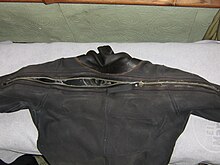
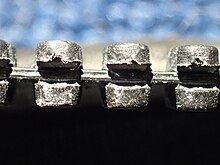
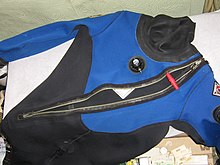


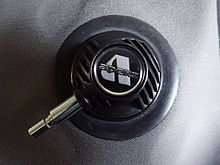

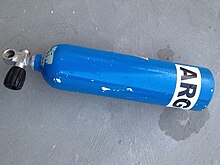



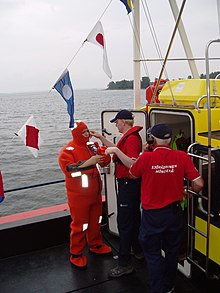
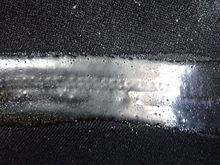
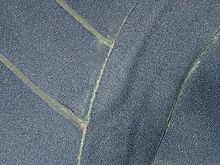
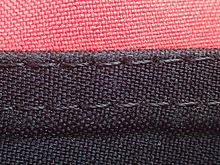
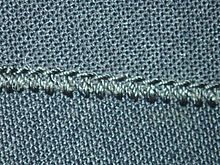



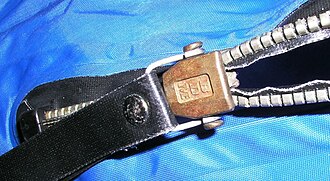
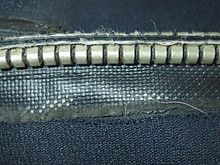



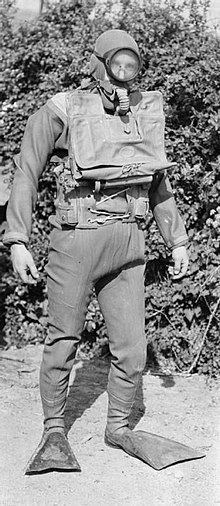

No comments:
Post a Comment